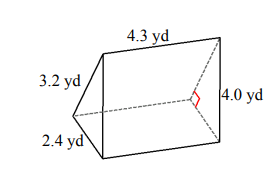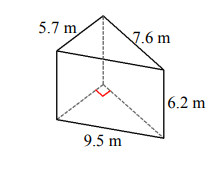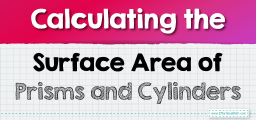How to Find the Volume and Surface Area of a Triangular Prism?
In this step-by-step guide, you learn how to use formulas to find the volume and surface area of a triangular prism.

The prism is a solid shape with flat faces, two identical bases, and the same cross-section along its entire length. The name of a particular prism depends on the two bases of the prism, which can be triangular, rectangular, or polygonal.
Related Topics
A step-by-step guide to finding the volume and surface area of triangular prism
A triangular prism is a three-dimensional polyhedron with three rectangular faces and two triangular faces. The \(2\) triangular faces are congruent to each other, and the \(3\) lateral faces which are in the shape of rectangles are also congruent to each other. Thus, a triangular prism has \(5\) faces, \(9\) edges, and \(6\) vertices.
See the image below of a triangular prism where \(l\) represents the length of the prism, \(h\) represents the height of the base triangle, and \(b\) represents the bottom edge of the base triangle.
Triangular prism properties
The properties of a triangular prism help us to easily identify it. The following are some features of a triangular prism:
- A triangular prism has \(5\) faces, \(9\) edges, and \(6\) vertices.
- It is a polyhedron with \(3\) rectangular faces and \(2\) triangular faces.
- The two triangular bases are congruent with each other.
- Any cross-section of a triangular prism is in the shape of a triangle.
Triangular prism formulas
There are two important formulas for a triangular prism, which are surface area and volume.
The volume of a triangular prism
The volume of a triangular prism is the product of its triangular base area and the length of the prism. As we already know that the base of a triangular prism is in the shape of a triangle. So,
\(\color{blue}{Volume\:of\:a\:triangular\:prism\:=\:area\:of\:base\:triangle\:×\:length\:=\frac{1}{2}\:×\:b\:×\:h\:×\:l}\)
where,
- \(b\) is the base length of the triangle,
- \(h\) is the height of the triangle,
- \(l\) is the length of the prism.
The surface area of a triangular prism
The surface area of a triangular prism is the area occupied by the surface. It is the sum of the areas of all the faces of the prism. Therefore, the formula to calculate the surface area is:
\(\color{blue}{Surface\:area\:=\left(Perimeter\:of\:the\:base\:×\:Length\:of\:the\:prism\right)\:+\:\left(2\:×\:Base\:Area\right)\:=\:\left(S_1\:+S_2\:+\:S_3\right)L\:+\:bh}\)
where,
- \(b\) is the lower edge of the base triangle,
- \(h\) is the height of the base triangle,
- \(L\) is the length of the prism,
- \(S_1, S_2,\) and \(S_3\) are the three edges (sides) of the base triangle,
- \((bh)\) is the combined area of the two triangular faces because \(\left[2\:×\:\left(\frac{1}{2}\:×\:bh\right)\right]\:=\:bh\).
The lateral surface area of the triangular prism
The lateral surface area of any solid is the area without the bases. In other words, the lateral surface area of a triangular prism is calculated without considering the base area. Thus, the lateral surface area of a triangular prism is:
\(\color{blue}{Lateral\:surface\:area =\:\left(S_1\:+\:S_2\:+\:S_3\right)\:×\:l\:=\:\left(Perimeter\:×\:Length\right)\:or\:LSA=\:p\:×\:l}\)
where,
- \(l\) is the height (length) of a prism
- \(p\) is the perimeter of the base
Finding the Volume and Surface Area of Triangular Prism – Example 1:
Find the volume of a triangular prism where the base of the triangle is \(8\:??\:\), its height is \(6\:??\:\), and the length of the prism is \(10\:??\:\).
Solution:
The base of the triangle is \((b) = 8\space in\), and the height of the triangular base \((h) = 6\space in\).
So, the base area \(= (\frac{1}{2})(bh) = (\frac{1}{2}) × (8 × 6) = \frac{48}{2}=24\space in^2\).
The length of the prism is \(L = 10\space in\).
Using the volume of the triangular prism formula,
The volume of the given triangular prism \(=base\:area\:×\:length\:of\:the\:prism = 24 × (10) = 240\space in^3\).
Exercises for Finding the Volume and Surface Area of Triangular Prism
Find the volume and surface area for each triangular prism.




- \(\color{blue}{V=43.2\:yd^3, A=93.6\:yd^2}\)
- \(\color{blue}{V=16.5\:yd^3, A=49\:yd^2}\)
- \(\color{blue}{V=134.3\:m^3, A=184.7\:m^2}\)
Related to This Article
More math articles
- The 5 Best Computers For College Students
- The Role of Math in Game Design
- Top 10 Geometry Books for High School Students
- Full-Length 6th Grade SBAC Math Practice Test
- How to Solve Word Problems of Absolute Value and Integers?
- GED Math Test-Taking Strategies
- How to Master Calculus: A Beginner’s Guide to Understanding and Applying Limits
- FREE 5th Grade MAP Math Practice Test
- Unlocking the Secrets of Inscribed Polygons
- Slope Fields Simplified: Understanding the Core of Differential Equations





















What people say about "How to Find the Volume and Surface Area of a Triangular Prism? - Effortless Math: We Help Students Learn to LOVE Mathematics"?
No one replied yet.